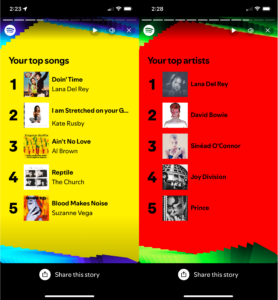I was an early user of Spotify when it came to the United States and have been an active listener ever since. I listened to music on the audio service for 20,981 minutes this year. That’s 14.6 days! And Lana Del Rey was—by far—my most listened to artist…hey, I’m a proud sucker for that cinematic, swoony persona. How do I know these stats? Spotify Wrapped, the company’s annual wrap-up/data dump of its customers’ listening habits, recently dropped.
Wrapped has become something of a big deal among devoted Spotify users—and probably an annoyance to all those users’ friends and acquaintances. After Wrapped is released, it’s as easy to find screenshots of folks’ listening habits on social platforms as it is to find coffee shops in Portland. Although you probably never wondered what your boss’ favorite song of the year was, they may well tell you. Data is powerful stuff!
Along with all those juicy details around listening habits, Spotify threw in a new feature this year: a short, genAI-created podcast, powered by Google’s NotebookLM. In approximately three minutes, two podcast “hosts” casually discuss your top artists, songs, and genres, with all the usual banter and interplay of podcasters that have recorded together for a while. Those hosts were, however, not humans but voice AI speech generated from a genAI-created script.
This may be the first widespread exposure consumers get to what very good text-to-speech plus genAI can sound like. When Google publicized its Duplex assistant back in 2018, there was a flurry of press, but it was mostly a topic of conversation for the Technorati. And speech AI vendors put demos out on the web that show off what “good” can be. But by sending these podcasts out to its millions of subscribers, Spotify has increased awareness of compelling text-to-speech by at least an order of magnitude.
OK, so what does this have to do with customer experience? The Web is littered with surveys and think pieces that proclaim that consumers don’t want to use conversational AI as their main mode of customer service. But I’ve never been satisfied with such surveys, primarily for two reasons:
- The surveys very rarely try to get consumers to envision a situation where the conversational AI experience is equal in quality to a human-assisted service experience.
- And relatedly, consumers have not had a lot of experience with such speech-enabled LLMs. They cannot easily imagine what a great voicebot would feel like.
Well, along comes Spotify to open our collective minds. I am not claiming that, starting this week, consumers will be clamoring to avoid human contact center agents in their rush to choose voice AI. Spotify has a large customer base, but it is certainly not omnipresent, nor will many of the consumers that experience the Wrapped AI podcast even think through what it means that the conversation was generated from their usage data and the voices generated whole cloth. But this is just the start—Spotify (and a savvy Google using Spotify as a stealth advertising channel) will just be the first step towards consumers’ understanding of just what this stuff will be able to do and how natural the experiences could feel.
Categories: Conversational Intelligence, Intelligent Assistants, Articles


 Getting It Right: What AI Agents Actually Mean for Customer Support (Webinar)
Getting It Right: What AI Agents Actually Mean for Customer Support (Webinar)  Beyond the Basics: How AI Is Transforming B2B Sales at TP
Beyond the Basics: How AI Is Transforming B2B Sales at TP  Five9 Launches Agentic CX: Toward AI Agents That Reason and Act
Five9 Launches Agentic CX: Toward AI Agents That Reason and Act  2025 Conversational AI Intelliview: Decision-Makers Guide to Self-Service & Enterprise Intelligent Assistants
2025 Conversational AI Intelliview: Decision-Makers Guide to Self-Service & Enterprise Intelligent Assistants